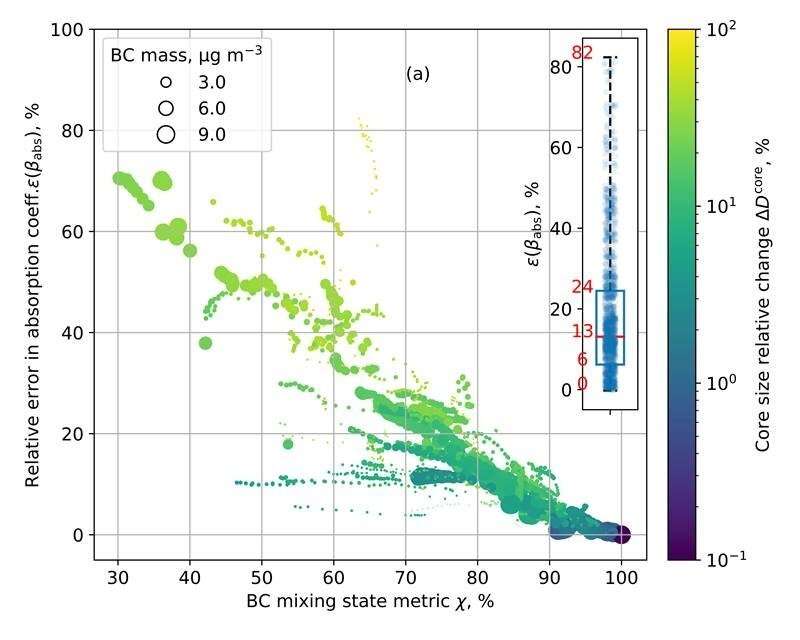This article has been reviewed according to Science X's editorial process and policies. Editors have highlighted the following attributes while ensuring the content's credibility:
fact-checked
peer-reviewed publication
trusted source
proofread
Particle errors: Quantifying the effects of simulation mixing state on aerosol optical properties

Particles in the atmosphere affect global climate. For example, the black carbon from burning fossil fuels absorbs and radiates light and heat. To calculate the effects of aerosols on climate, scientists rely on simulated aerosol fields. How these models represent aerosol mixing state potentially introduces large uncertainties into climate calculations. This is because the simulated aerosol optical properties—how particles absorb and scatter light—are sensitive to mixing state. Mixing state refers to how various properties are distributed across the particles in the air.
In a new study published in Atmospheric Chemistry and Physics, researchers have systematically quantified the effect of aerosol mixing state on aerosol optical properties. To do so, they used an ensemble of 1,800 aerosol populations from different particle-resolved simulations. These complex simulations operate on the scale of single particles.
Investigating the impacts of aerosol mixing state on aerosol optical properties is important for both modeling and experimental studies. This new paper approaches this topic by using particle-resolved simulations as a benchmark. It applies this benchmark to determine the error in optical properties when using simplified aerosol representations. These simplified representations are common in state-of-the-art aerosol models. The researchers disentangled the causes for biases in the prediction of optical properties that are introduced by assuming that particles mix within prescribed size bins. Some of these errors are large enough to warrant caution when calculating how particles directly affect climate.
Within the study, a research team systematically quantified the errors introduced by internal mixture assumptions used in sectional aerosol models. The internal mixture assumption generally led to an overestimation of the volume absorption coefficients and an underestimation of the volume scattering coefficients. The relative errors for ϵ(βabs) and ϵ(βscat) reached as high as 70% and −32%, respectively. The absorption overestimation and scattering underestimation resulted in a consistent underestimation of single scattering albedo, with errors as great as −22.3% and median errors of −0.9%. The relative error in the volume absorption coefficient ϵ(βabs) displayed a similar pattern for relative humidity of 50% and 90% compared to the dry environment. The relative error in the volume scattering coefficient ϵ(βscat) decreased at higher relative humidity because of the enhanced scattering cross-section through hygroscopic growth.
The team included researchers from the University of Illinois Urbana-Champaign, the Japan Meteorological Agency, the Japanese National Institute of Polar Research, the Japanese Research Institute for Humanity and Nature, and the National Center for Atmospheric Research.
More information: Yu Yao et al, Quantifying the effects of mixing state on aerosol optical properties, Atmospheric Chemistry and Physics (2022). DOI: 10.5194/acp-22-9265-2022
Journal information: Atmospheric Chemistry and Physics
Provided by US Department of Energy





















